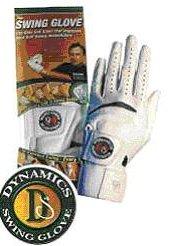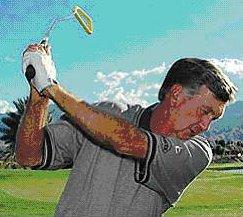The Truth About Golf Training Aids
- by Kelvin Miyahira
If you’re ever up early watching those infomercials on the Golf Channel and were wondering whether or not the latest gizmo was going to work for you, here’s some helpful advice. The number one rule of thumb is this: if a product is going to work, it must force YOU to do one of two things:
- Apply muscular effort against some type of resistance in order to obtain correctness or
- Provide feedback (right or wrong) in some fashion.
The reason? The neuromuscular component to learning and executing new movements is highly dependent upon factors beyond your conscious control. And what might be even more important is that what works best is totally illogical.
Let me give you a few of examples of how a product designed to help you can actually work against you. Not to pick on anyone but this is out there in the public so it’s fair game. The Rick Smith Dynamics Swing Glove. The Swing Glove is designed to keep your wrists from cupping or bending too much. Many golfers suffer from these problems so this device is a good idea.

But analyze this deeper. The hard plastic manufactured into the glove prevents your left wrist from bending and cupping. So what happens when your left wrist tries to bend against it? It feels resistance doesn’t it? Let’s take it a step further. Say you use this training device religiously. Because your left wrist is constantly bending against the plastic piece (resistance), isn’t it eventually going become stronger when doing that movement? The effect of the plastic piece may be compared to that of a dumbbell. When we do a bicep curl against resistance, we get stronger in that bicep motion. So isn’t it logical that after using the glove you’ll get stronger to do the exact thing you don’t want to do?
The Matzie Assist has been on the market for a long time and I’m sure they’ve sold a ton of these. The Assist does exactly what it says in terms of turning your hands over. Using a bent shaft with a heavy head, this product actually turns the club over or closes the clubface over for you. Supposedly, the correct “feel” is going to be transferred over to you as you hold and swing the training aid.

Let’s take this a step further. If some product is doing something for you, then what exactly are you doing? Nothing, but going along for the ride. If that is so, neurologically, is your body being engaged in the process? If not, then how can learning occur?
A simple analogy further illustrates that point. You know you can get stronger and build muscles by lifting weights but what would happen if instead of you doing the work, you had a machine that lifted the weights for you while you munched on doughnuts and drank your Frappacino. Are you going to get stronger? Or build any muscle?
Or how about a left arm straightener? If the device is like a splint that prevents your arm from bending, there will be no effort on your part to keep your arm straight. This may be taking it one step too far but think about what happens when you put your arm in a cast for a month. Atrophy. Hmmm. So we know that that can’t be good.
What do these examples suggest? A common thread is that the neuromuscular systems are so important and must be engaged in order to train/learn movements. And instead of using a training aid that supposedly helps you do the right thing, the opposite is better. Everyone needs a training aid that enables them to do the WRONG thing. Then you must fight against that resistance to correct it or have the feedback show you when you’re doing it right or wrong. Make sense?
For example, if I want a student to learn not to sway off the ball, I would push him/her even farther off the ball to force them to learn how to use the muscles involved in stability.
If a student can’t turn, then should I help him/her turn? Absolutely not. I will hold his/her shoulders and make him/her work against the resistance of my hands preventing their shoulders from turning. Then, when the resistance is taken away, the student is stronger and able to turn better. Logical?
This brings me to the topic of last month’s problem student – the bicep flexing of Melanie Ito and the solution to her problems. If I could cure her of the casting, chicken-wing motion, it would enlighten me and other instructors on the best ways to correct these problems that are so common amongst the weekend warriors.
The main problem is how to get her triceps to fire (which extends the arm) instead of having the biceps instinctually firing? Sequencing these contractions is important as well.
A Better Way? A Dream Way???
What if there was a $10 million computerized setup that you could step into to obtain the perfect, and I mean Tiger-good, swing? This device would have you working against resistance that allows you to develop a great motion, correct muscle firing patterns, clubhead speed and a repeatable golf swing thereafter. All you would have to do is hook yourself up to some EMG sensors, biomechanical wireless sensors, force plates, electrical muscle stimulators and more. Then, using all the real time feedback data available, the computer could program your brain and nervous system to fire in the exact sequence, speed and accelerations as Tiger.
Now wouldn’t that be cool? Of course, you wouldn’t be able to get it all in a day. But just a few short visits to the lab per week are enough to begin to develop the Tiger swing.
What’s the Catch?
The catch is, even with the best technology available, you must go to the lab about 3-5 times per week.
Will that be a problem? Of course not. Those frequent visits are a small price to pay if at the end of a few short weeks, you’ll be swinging like Tiger.
It’s Too Easy
As with all computers or software programs it takes a genius to develop it, but once that’s done, anyone can operate it or use it. The mystery of movement pattern development could be solved by someone so that others can simply step into the lab, put on all this computerized gear and follow the program. Joe and Jane Average go into the lab and come out looking like Tiger.
The science is already there to flatten our tummies by electronic contractions so why not contract our muscles sequentially to make us swing like Tiger?
Just imagine, instead of hitting ball after ball incorrectly at the range and not knowing whether or not you’re doing anything right, you’d be able to instantly produce Tiger’s swing and hit the ball. No thinking. No wondering. Just do it. Like Tiger.
Can It Be Done?
Career chicken winger Melanie Ito really excelled at the chicken wing, bicep firing swing that is so common. Ball striking problems, consistency, direction problems were all arising from the dysfunctional patterns.
So here is her Tiger-ish swing while using the lab device. Can you imagine that only a few minutes per day is enough?
*Note: These are real pictures grabbed from a video of a swing using a pound and a half maintenance/training device designed with the right resistance to produce great swings. There are not posed pictures.




Still Hard to Believe?
The human body and the neuromuscular system are incredible in performing their functions during a golf swing.
Golf swings are a series of pre-programmed muscle firings (whether right or wrong) built into subconscious feedback system of proprioceptors, which are called Golgi tendons and muscle spindles. These proprioceptors are sensing changes in muscle length, spatial positioning, force load and executes movements without your conscious thought. The neuromuscular system will do what is instinctual based on the million years of hunting and gathering food as well as running to escape being a Tyrannosaurus Rex’s next meal.
Golfers with great swings can ignore the proprioceptive feedback and swing the club in an appropriate way but for those who can’t do that, there are ways to stop the inevitable bad instinctual moves. The first way is to manually and consciously override the CNS with analytical thought. This can be done with a certain move in mind but not with the entire swing. Chances are, this is the way most people try to learn golf and this is why it is so difficult.
The second way is to override bad CNS patterns that are hardwired into your neural system. This would be done by presenting the body with an uber high-tech, multi-million dollar computerized resistance with electronic muscle stimulators that elicits correct sequencing/patterning of muscular contractions which would result in a “Tiger” swing. Wouldn’t that be great? Might cost an arm and a leg for you to use each time but at least you’ll develop a Tiger swing.
Unfortunately, the multi-million dollar computerized equipment that can give you a Tiger swing after only minutes of use has not been developed yet. But here’s my specially designed, variable resistance, heavy training aid with a grip ended center of gravity that can help you recruit larger muscles in the swing, create tremendous lag and have you produce more vertical ground force during the swing.
The proof of effectiveness is in Melanie’s new swing. Not only did it create wonderful sequencing during training, it also transferred over into her real swing when hitting the golf ball.
In a later article, I will detail more research findings in regards to why a golf club is the perfect device to train casting or early releasing. This might explain why so many have this problem and how it can be fixed. Also, I’ll get into which arm might be the arm that causes most poor impact positions. The results were not what I had expected.

